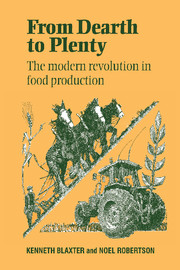Book contents
- Frontmatter
- Contents
- Preface
- Acknowledgements
- PART ONE The social, economic and political context of agricultural change
- PART TWO The science and technology of the modern agricultural revolution
- 3 Problems of measurement
- 4 Mechanisation
- 5 Soils, fertilisers and water
- 6 The control of weeds, pests and plant diseases
- 7 Breeding more productive plants
- 8 Integrations and innovations in crop husbandry
- 9 Hunger in the midst of plenty
- 10 Better and more productive animals
- 11 Animal health and disease
- 12 Integrations in animal husbandry
- PART THREE How did the science-based revolution happen, and what is the way forward as support is withdrawn?
- Glossary
- Index
4 - Mechanisation
Published online by Cambridge University Press: 04 August 2010
- Frontmatter
- Contents
- Preface
- Acknowledgements
- PART ONE The social, economic and political context of agricultural change
- PART TWO The science and technology of the modern agricultural revolution
- 3 Problems of measurement
- 4 Mechanisation
- 5 Soils, fertilisers and water
- 6 The control of weeds, pests and plant diseases
- 7 Breeding more productive plants
- 8 Integrations and innovations in crop husbandry
- 9 Hunger in the midst of plenty
- 10 Better and more productive animals
- 11 Animal health and disease
- 12 Integrations in animal husbandry
- PART THREE How did the science-based revolution happen, and what is the way forward as support is withdrawn?
- Glossary
- Index
Summary
Men, horses and machines
Although the horse was the general source of power on the British farm at the beginning of our period, it must not be forgotten that the steam tractor was an important power source in certain parts of the country 50 or more years earlier. The steam tractor was able to plough the flat fields, sometimes of heavy soil, in the eastern counties using a reversible plough pulled between two tractors at either side of the field. It was also a source of power for the threshing machines, which travelled between farms. However, the main source of power on farms in general was the horse; the most obvious change that has taken place during the course of the modern agricultural revolution has been the disappearance of people actually seen to be working the land. This is of course more obvious in the arable areas. Where formerly there were slow pairs of horses ploughing at the rate of a few acres per week, gangs of workers singling sugar beet day after day, and family parties setting sheaves in stooks following the binder, now there are rapid forays by machines with scarcely a person to be seen. In livestock areas it is much the same. The night and morning routine of the shepherd has been replaced by the quick visit to his flock by the part-time stockman in his Landrover or on his four-wheeled motorbike; gone too are the gangs of milkers to be replaced by the lone, hard-worked dairyman in his clinically efficient milking parlour.
- Type
- Chapter
- Information
- From Dearth to PlentyThe Modern Revolution in Food Production, pp. 56 - 66Publisher: Cambridge University PressPrint publication year: 1995

